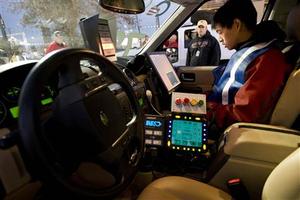Cars sprouting whirling lasers on top, moving cameras on the sides, and banks of computers inside sped through the streets of a California desert ghost town on Saturday in a robot race -- no drivers needed.

|
| ©REUTERS/Hector Mata
|
| A member of the Massachuset Institute of Technology (MIT) team tunes their autonomous vehicle's computer before the start of the Defense Advanced Research Projects Agency (DARPA) Urban Challenge race in Victorville, California November 3, 2007.
|
Spectators gasped as cars with empty driver's seats pulled out of the starting blocks, steering wheels turning on their own, and headed into the neighborhood streets of a deserted air force base.
Stanford University's "Junior" was the first to pass the finish line, followed by cars outfitted by Carnegie Mellon University and Virginia Tech within the six-hour time limit.
The joint University of Pennsylvania-Lehigh University vehicle arrived close to the limit, while cars from the Massachusetts Institute of Technology and Cornell University were the last of the 11 finalists to get through the course, both arriving about seven and a half hours after the start.
The winner of the $2 million prize, scheduled to be named on Sunday, will be determined based on safety as well as speed through the 60-mile (100-km) course.
Hundreds of spectators turned out for the event, including 10-year-old Vernon Bussler, who compared the results to a robot arm and scorpion he had made out of Lego play bricks. "It's just different from the Lego -- just way more things on it," he said.
Encouraging future scientists is part of the goal of the robot car race, the latest U.S. Defense Department challenge to universities, companies and inventors who last turned out in 2005 to send self-controlled vehicles more than 100 miles (160 km) through the desert between Los Angeles and Las Vegas.
The cars run completely by computer, without human intervention, using sensors to plot and pick their way.
Saturday's Urban Challenge sent them along neighborhood roads, through traffic and around jams created by humans. About 50 humans piloted cars equipped with roll cages -- in case of robot road rage.
Over and over, cars with a warning honk and roof-rack of space-age gear came to a perfect halt at the stop sign of a deserted intersection, then pulled through smoothly. The most spectacular error was a minor fender bender which did not stop or significantly damage either vehicle.
MONOTONY OF SUCCESS
Five finalists bogged down early. One car ended up in a driveway, its sensors continuing to swivel. A 24,500-pound (11-tonne) self-controlled green truck called the TerraMax halted inches away from mowing down a column. In qualifying events, robot cars simply stopped, lost in thought, climbed over curbs and sideswiped parked vehicles in this windy desert facility 80 miles northwest of Los Angeles.
"It's getting a little monotonous to see everybody do so well," joked Gerry Mayer, director of Lockheed Martin's Artificial Intelligence Laboratories, which worked with the University of Pennsylvania and Lehigh.
That's a lot better than the first Grand Challenge by the U.S. Defense Advanced Research Projects Agency (DARPA), the Defense Department's research arm, a 2004 cross-desert race with no finishers.
Chris Yakes, Oshkosh Truck Corp's advanced products director, described how a computer memory error ended the first trial for his truck. "The last thing it saw was a bush in front of it," he sighed.
An Oshkosh truck finished the 2005 desert race with flying colors, although its Urban Challenge entry, the TerraMax, did not finish.
"Other than having a kid or getting married, I don't know if there's anything more exciting than seeing your robot coming over the horizon and bounding past the finish line at 45 miles per hour," Yakes said, remembering the 2005 race.
Oshkosh trucks supply U.S. troops in Iraq and elsewhere and a driverless version is exactly what DARPA needs to cut the number of soldiers' lives at risk in battle.
Universities also see interesting artificial intelligence problems to solve, and corporations see the building blocks of an automobile of the future.
Reader Comments
to our Newsletter